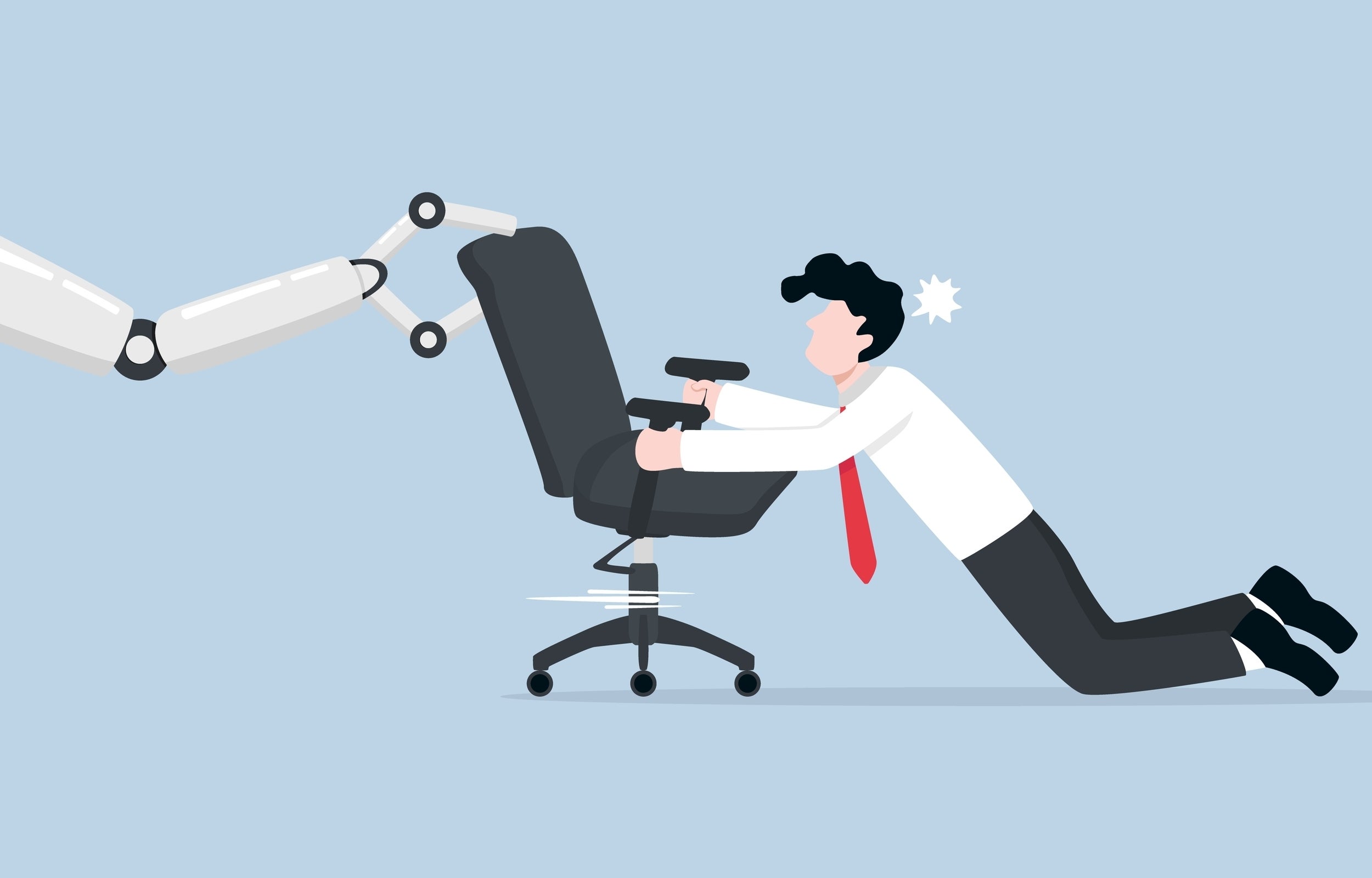Banner artwork by Tallulah Fontaine
Career transitions, when made strategically, are something to be embraced by both the in-house attorney and their organization — especially in an era of disruptive technologies, such as widely available artificial intelligence (AI) tools, that are shaking up the legal landscape. Adaptable in-house lawyers who can transfer skills to new areas add value to their organizations and thrive amid business and legal tech evolution.
Why do lawyers fear change?
Lengthy investments into a singular function or role can create an indelible mark on how lawyers self-identify. This, coupled with the fact that lawyers are already prone to tying a portion of their identity to their jobs, means the notion of career transitions away from the familiar can represent a loss of identity. Change can be unnerving, and the unknown can be uncomfortable, but the riskiest option of all is remaining stagnant.

Many of the reasons attorneys are averse to change are not unique to lawyers. There was an adage circulating on LinkedIn a few years ago that essentially said, “You don’t owe me for the 30 minutes I spent doing the work, you owe me for the 10 years I spent learning how to do it in 30 minutes.” This quip succinctly describes the human experience of desiring a return on investment for a decade of pouring effort and passion into a certain subject matter, as well as the desire to benefit from the efficiencies that come from such an investment. On top of that, within the course of a decade spent mastering a subject area, lawyers are particularly likely to adopt the role of “subject matter expert” as part of their professional — and even personal — identity.
Crossing T’s and dotting I’s
In-house attorneys who dive deep into a specialized area of law see amazing benefits to their careers. The famous concept of a “T-shaped” lawyer suggests that the ideal first stage of an in-house counsel’s career is to go deep before going wide.
To be clear, lawyers who opt to stay in this vertical — or column shaped — stage of their careers, something we will call an “I-shaped” career, will no doubt have vast opportunities to demonstrate their proficiency at applying highly prized legal skills. It is not necessary for lawyers to change legal subject matter areas to increase their value to their organizations and enjoy an enriching and fulfilling career. But, as suggested by the imagery of a T-shape, there are also compelling advantages to branching out into unfamiliar terrain. Ultimately, however, the shape of a lawyer’s specific career trajectory is less important to staying relevant in the era of AI than how aptly that lawyer displays his or her ability to shift, pivot, and evolve in parallel with the business’s needs.
A lawyer's confidence should be rooted in his or her ability to learn new things and adapt as new needs arise.
A lawyer’s confidence should be rooted in his or her ability to learn new things and adapt as new needs arise. This ability can be demonstrated as both a “T-shaped” or an “I-shaped” lawyer, or as a combination thereof, or something else entirely.
Staying relevant in an era of AI disruption
The question on many (if not most) in-house attorneys’ minds is: “How do I stay valuable and relevant in an era of disruptive technology?”
Organizations are expecting a rapid improvement to AI. We are all, invariably, going to work differently because of AI, and there will likely be some contraction in the legal industry. However, organizations will always need a combination of technology and people. Companies will begin to expect their in-house attorneys to become comfortable with this technology.

In-house attorneys should be making a concerted effort to engage with AI and become comfortable with drafting prompts. In short, attorneys cannot look away from this technology — it is going to have a massive impact on the in-house practice of law in areas such as legal research, drafting contracts, document review, and due diligence, to name a few examples.
In the present and future economy, a lot of legal work is going to rely on such disruptive technologies, and if an attorney is to continue to add value to their organization, that lawyer’s fluency with these technologies is going to be imperative.
While machines outperform humans in efficiency, the value of tasks that require the human touch will increase over time.
However, law departments also need to ask questions about specific aspects of attorney work that people do even better than AI. Indeed, even if AI can excel at a particular task, organizations may still want people to execute those functions, given the magnitude of their impact on the business. Attorneys themselves should be reflecting and capitalizing on the irreplaceable, quintessentially human aspects of their work.

It may be that humans excel at galvanizing people to work in an orchestrated way. Humans shine at helping people understand complex ideas and persuading others. Humans are also empathetic listeners and compelling storytellers. While machines outperform humans in efficiency, the value of tasks that require the human touch will increase over time.
Attorneys should consider strategically planning their career trajectories, recognizing that automation may replace certain functions.
Compelling reasons to consider a T-shaped career trajectory
Lawyers who see a strategic reason to make a career change, but resist doing so due to self-imposed mental barriers, may eventually fail to adapt to the changing landscape. Expertise can often be automated, insourced, or outsourced — but being able to recognize and adjust to an organization’s changing needs creates ongoing value to a business.
In-house attorneys should also recognize that branching out does not mean they are losing the expertise they have invested in mastering. Lawyers should be assessing their core skills at the most fundamental level by breaking those skills down into component parts, prompting the ultimate question:
What am I uniquely trained to do?
Organizations benefit most from having legal talent who can be successfully deployed wherever the business needs are most gripping. An organization may consider building a pipeline of legal talent with a scaffolded approach:
- The base level: Attorneys who have recently been brought in to do a certain job and are still demonstrating that ability.
- The second level: Attorneys who have demonstrated their excellence in their assigned area and are now ready to show they can successfully transfer to a new area either as a special project or a temporary assignment.
- The top level: Attorneys who have demonstrated their ability to evolve and learn by identifying which legal skills are transferable and then successfully applying such skills across subject and business areas.
Businesses benefit from having their top legal talent deployable as needed when new business challenges arise. Regardless of where on the “I-shaped vs. T-shaped" spectrum an attorney identifies, his or her track record of being innovative and adaptable is what best supports his or her continuing, or even increasing, relevancy to that attorney’s organization.
Strategic shifts unlock richer career trajectories
Organizations recognize that ensuring their in-house team’s satisfaction with career progression is crucial in developing a pipeline of legal talent. But, attorneys are responsible for asking themselves what gets them animated at work: Is it distilling and communicating to non-lawyers complex information, or is it taking big ideas and expressing them through concise, accessible language? When attorneys pinpoint what aspects of their role energize them, they naturally become more effective in leading and solving problems, thereby benefiting their organization.

Exploring the parts of law that will ignite a lawyer’s drive might not be possible through an upward career transition, and not all strategic transitions should be geared toward upward mobility.
Lawyers can enhance their organizational value through lateral moves, which offer opportunities for learning, development, increased job security, demonstration of capability, and accumulation of diverse experience in the evolving legal and business environment.
Despite an underlying fear of change, most lawyers want to be challenged and do not want to become overly comfortable in one function. There is an innate human desire to do things a little differently on a periodic basis. Lawyers can enhance their organizational value through lateral moves, which offer opportunities for learning, development, increased job security, demonstration of adaptability, and accumulation of diverse experience in the evolving legal and business environment.
Meeting the moment with open-mindedness
There is no single formula for what a top in-house lawyer’s career should look like, and there are infinite possibilities in that regard. Even the “I-shaped” vs. “T-shaped” career trajectory is a false dichotomy. There are elite in-house lawyers at top organizations who have climbed the corporate ladder without ever making the jump to a new legal field. Even within a single area of law there are endless things to learn and master.
Stagnation is most likely to occur when a lawyer foregoes what is strategic in favor of what is familiar out of discomfort or aversion to change. Stagnation is likely to occur when attorneys cannot break free from the constraints of self-imposed labels or how invested those attorney feel in the specific identities they’ve created for themselves.
Attorneys who seize opportunities to showcase adaptability, problem-solving in new situations, and the ability to leverage new technologies for their work are poised to excel as technologies and business needs rapidly evolve. Ultimately, the key to thriving in an era of disruptive technologies is not by identifying as either a “T-shaped” or “I-shaped” lawyer, or as an expert in a particular subject, or as a generalist, but rather identifying as an emboldened legal practitioner, innovative problem solver, and adaptable business partner with confidence rooted in one’s ability to meet the moment.




